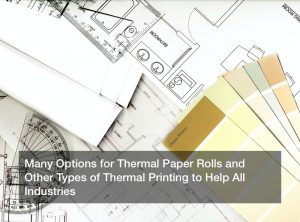
Considering the massive increase of paper documents that appear nationwide every year, there is much to be done with the types of paper that are used for all different printed needs. Now, the increase of about 22% annually, there is much to consider about the amount of paper used along with the type of paper that is used for all of these needs. It could be for work along with the need to print out receipts when shopping, invoices received with packages, and much more.
Printing thermal receipts for every purchase, thermal paper rolls help keep the management of these in order. Thermal paper rolls are often longer, and maintain printable ink for the longest period of time. This means it has been helpful for the upgrade to things like thermal fax paper, POS thermal paper, plotter paper, and others over the years. With the safest and least amount of ink used on these grades of paper, following the initial technology of laser printing, there is much to consider about which option is most eco-friendly.
The Initial Need for Thermal Paper Rolls
It is easiest to see the need for thermal paper rolls at registers for the print of receipts, coupons, balances, and more. You may notice the very long receipts printed from many stores when using a credit or debit card, along with the use of store membership or coupon cards. With all of the details printed out in the receipt, some of them are so very long.
The easiest change to thermal printing came with the need for credit card receipts, especially with the increased use of cards because of the safer value they hold when being carried. Because consumers cannot replace cash if a purse or wallet is stolen, cards are much more secure and can be replaced and reported as stolen. So, with the change of credit card paper over the years to more thermal paper rolls, there are many others that are included in other retail, food, ATMs, and many additional locations. All across our nation, the use of thermal printing has become the most efficient over time.
Various Types of Thermal Printer Paper
Many different types of thermal paper are available, whether they are thermal paper rolls or others. Considering the many locations that use thermal paper, there is much to be considered in the over four trillion paper documents that are printed annually in the United States. Thermal printing has likely brought much technological improvement, though there will likely be different locations where credit card paper rolls are helpful, there are many different types of paper that specifically fit those machines and meet the functions that they complete. Some of these different types of thermal paper rolls include:
- ATM paper rolls
- Custom printed paper rolls
- Receipt paper rolls
- POS paper rolls
- Plotter rolls
- Heavyweight thermal paper
- Credit card thermal rolls
- Thermal fax paper roll
- Thermal credit card rolls
All of these paper rolls replace the historical printing processes greatly, mostly including the credit card payments as they were previously processed with carbon receipts later sent to the bank to pay for a bill. Thermal paper rolls are the receipts for automated and computer-recorded transactions, there is an immediate process to complete a purchase based upon the available balance in a bank account or on a credit account. All stores can ensure a well-stocked amount of all types of paper needed to make sure that transactions for customers are always properly recorded.
With various printing machines around in every business, including retail and corporate printing, the productivity and technology of all locations must be managed. Interestingly enough, with the amount of printing done annually, the proper type of paper is important as well as other office products. Retail stores, especially groceries, have self-checkout stands to help with the fluidity and efficiency of the purchase process. If paper or ink is not easily replaced, the use of thermal printing is helpful as an option for custom printed rolls. These and many others are all part of today’s automated and computer-recorded transactions, helping with the immediate purchase process allowing consumers to work for themselves.
